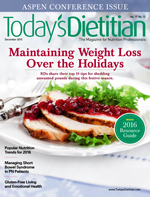 December 2015 Issue
December 2015 Issue
Ask the Expert: The Candida Diet — Does It Really Prevent Yeast Infections?
By Toby Amidor, MS, RD, CDN
Today's Dietitian
Vol. 17 No. 12 P. 10
Q: My clients have been asking about the Candida Diet, which is said to help prevent Candida, or yeast, infections. Can you share some background on yeast infections, what the Candida Diet entails, and how it purportedly prevents these infections?
A: About 75% of women will get a vaginal yeast infection during their lifetime, and 90% of people with HIV/AIDS develop Candida infections.1 Candidiasis is an infection caused by Candida albicans, a yeastlike fungus. It can infect the mouth, skin, stomach, urinary tract, and vagina. Oral infections, called oral thrush, are more common in infants, older adults, and people with weakened immune systems. Some people have recurring yeast infections and are now turning to the Candida Diet to help prevent and/or cure them.
Causes
Humans naturally have small amounts of Candida that live in the mouth, stomach, and vagina and don't cause any infections. Candidiasis, however, occurs when there's an overgrowth of the fungus, which may be caused by numerous factors including taking certain medications (eg, corticosteroids, antibiotics, certain birth control pills), having a bacterial infection, pregnancy, being overweight, or several health conditions such as HIV/AIDS, cancer, and psoriasis.1
The Research
Some studies suggest that reducing dietary sugar may help prevent Candida infections. In the body, Candida adhesion involves the human epithelial cells. Some carbohydrates have been found to help bind the Candida to the epithelial cells better than others. One study published in Microbial Ecology in Health and Disease looked at the dietary influence of various carbohydrates in vitro on the adherence of Candida to human epithelial cells.2 The study examined the effect of various carbohydrates including fructose, galactose, glucose, maltose, sorbitol, and sucrose. The results found that galactose and glucose promoted a higher adhesion as compared with maltose and fructose. Further, xylitol significantly reduced adherence of Candida to epithelial cells.
The Diet
According to Laurie Meyer, MS, RDN, CD, president of Laurie Meyer Nutrition in Milwaukee, who specializes in functional medicine and uses the LEAP (Lifestyle, Eating, And Performance) dietary protocol, the Mediator Release Test (MRT) to determine food sensitivities, and the SpectraCell test to assess micronutrient deficiencies, "The Candida Diet was a fad years ago, but Candida infection is real, and according to the CDC [Centers for Disease Control and Prevention], Candida infection may be on the rise in hospitals." However, there isn't any research on the Candida Diet. As such, there are no specific dietary guidelines, but Candida Diet advocates recommend the following dietary changes for improvement:
• Avoid carbohydrates: Supporters believe that Candida thrives on simple sugars and recommend removing them, along with low-fiber carbohydrates (eg, white bread).
• Avoid yeast-containing foods: Examples include beer, wine, vinegar, baked goods, and mushrooms.
• Use probiotics: Advocates say this will help introduce more "healthy" bacteria to the gut to help prevent a build-up of Candida. Yogurt with probiotics and/or supplements may be recommended.
• Candida cleanse: These types of diets tend to begin with detoxification, where fasting may be promoted, or a diet restricted to vegetable juice, colon cleansing, or consumption of herbs with antifungal properties.
The issue with many of these recommendations is that a variety of foods are restricted, which can lead to deficiencies in certain nutrients; in those with a weakened immune system, dietary restriction can cause a decrease in consumption of nutrients necessary to improve immune system function. In addition, there isn't enough research to suggest that dietary strategies help resolve Candida infections. However, in her 26 years in private practice, Meyer has found that "many people with Candida can actually have a gluten sensitivity or other food sensitivity. Once those are corrected, the Candida may improve." This is why it's so important to determine why the person is prone to Candida infection and where the MRT test can come into play, she says. For those with a Candida infection, Meyer recommends a diet that boosts immune function, beneficial bacteria, fiber, and nutrients, while decreasing sugar and processed foods.
— Toby Amidor, MS, RD, CDN, is the founder of Toby Amidor Nutrition (http://tobyamidornutrition.com) and the author of the cookbook The Greek Yogurt Kitchen: More Than 130 Delicious, Healthy Recipes for Every Meal of the Day. She's also a nutrition expert for FoodNetwork.com and a contributor to US News Eat + Run, Shape.com, and MensFitness.com.
References
1. Candidiasis. University of Maryland Medical Center website. http://umm.edu/health/medical/altmed/condition/candidiasis. Updated November 14, 2013. Accessed October 23, 2015.
2. Abu-Elteen KH. The influence of dietary carbohydrates on in vitro adherence of four Candida species to human buccal epithelial cells. Microb Ecol Health Dis. 2005;17(3):156-162.
